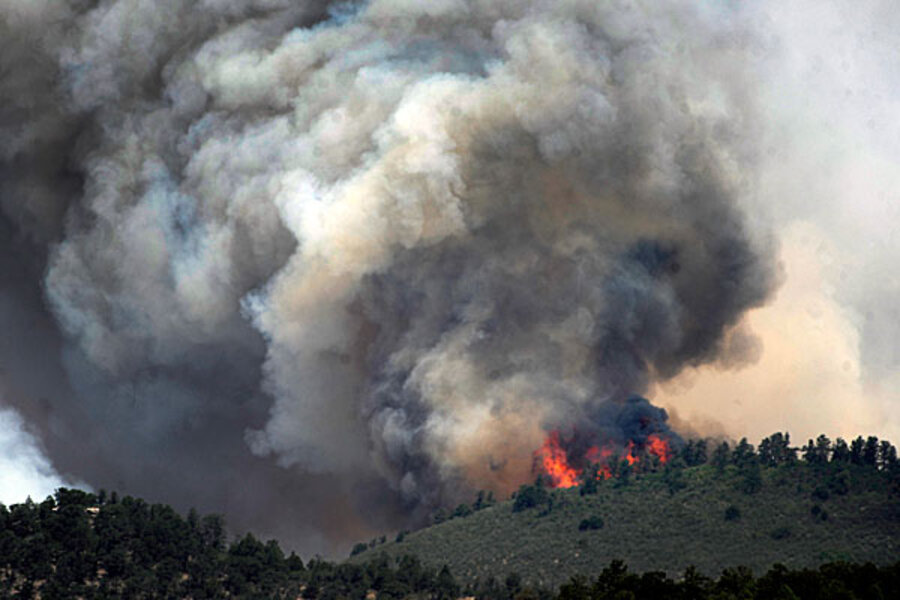Colorado wildfires keep Pikes Peak railway closed
Loading...
| Colorado Sprinds, Colo.
A wildfire roaring virtually unchecked near some of Colorado's most visited tourist sites kept some 4,800 people out of their homes on Tuesday on the outskirts of the state's second-most populous city, authorities said.
The so-called Waldo Canyon fire sent a mushroom cloud of smoke nearly 20,000 feet (6,100 metres) into the air over Colorado Springs near the foot of Pikes Peak, whose breathtaking vistas from the summit helped inspire the song "America the Beautiful".
Closer to the blaze, which has been fanned by stiff, hot winds blowing into the Southern Rockies from the prairies to the east, trees were visibly twisting from the heat of the flames.
IN PICTURES: Wildfires sweep the west
Operators of a famous cog railway that carries tourists from around the world up the picturesque mountainside said the trains would remain shut down on Tuesday for a third straight day.
The highway that leads up to Pikes Peak has been closed since shortly after the fire erupted on Saturday, as has the popular Garden of the Gods, a city-owned park encompassing scenic geologic formations such as tall, rocky spires and oddly balanced boulders.
The closures around Pikes Peak, billed the world's second-most visited mountain after Japan's Mount Fuji, have drawn attention to the fire's negative impact on the tourism industry just at the start of the peak summer travel season.
After three days, the blaze has scorched an estimated 4,000 acres (1,600 hectares), and fire crews managed to carve containment lines around just 5 percent of its perimeter. The cause was under investigation.
No casualties or property losses were reported, but thousands of residents have been displaced by evacuations.
Raging through dry timber about 80 miles (130 km) south of Denver, the Waldo Canyon fire had initially forced 11,000 people from their homes over the weekend, though residents from the town of Manitou Springs were allowed back on Sunday night.
As of late Monday, an estimated 4,800 people were under evacuation orders on the western outskirts of Colorado Springs.
One of them, Meg Duster, 27, stood watching the blaze from a safe distance at a fire command center. "I'm trying to remain optimistic, but it's so hard," she said, her voice quivering.
FIRE NEAR AIR FORCE ACADEMY
The U.S. Air Force Academy in Colorado Springs was still about 10 miles (16 km) away from the leading edge of the blaze, though fire officials had earlier listed the complex as being in harm's way. A recreation area belonging to the academy was ordered evacuated due to its proximity to the fire, and all trails leading west of the school were closed, the base said.
The wildfire was one of about a dozen burning out of control around Colorado, including the monster-sized High Park Fire near Fort Collins, a university town north of Denver close to the Wyoming border.
"We're going to be continuing to have to deal with these fires for weeks to come," U.S. Forest Service Chief Tom Tidwell said. "We anticipate it's going to be a long fire season."
The High Park Fire - the state's second-largest blaze on record and its most destructive ever - has consumed 83,205 acres (33,670 hectares) in steep canyons since it was sparked by lightning two weeks ago. It is blamed for the death of a 62-year-old woman in her cabin and has destroyed 248 homes.
An estimated 4,300 people remain evacuated from their homes as that fire burns through grass, brush and Ponderosa pine.
In southwestern Colorado, the Weber Fire grew to 8,300 acres (3,360 ha) overnight but firefighters held it about one mile southeast of the small town of Mancos, east of Mesa Verde National Park. Roughly 50 homes were evacuated, officials said.
Meanwhile, in neighboring Utah, a fast-growing 39,000-acre (15,780-ha) wildfire continued to rage largely out of control on Monday after burning an estimated 30 homes and killing 75 sheep between the rural communities of Fountain Green and Indianola.
Governor Gary Herbert, who toured the fire by helicopter on Monday, estimated the property losses so far at $7 million. No injuries have been reported, but Herbert said fire officials did use a helicopter to rescue some shepherds from the fire's path. (Additional reporting by Ellen Miller inGrand Junction, Deborah Zabarenko in Washington, and Jennifer Dobner in Salt Lake City; Writing and additional reporting by Mary Slosson; Editing by Eric Walsh and Alessandra Rizzo)






